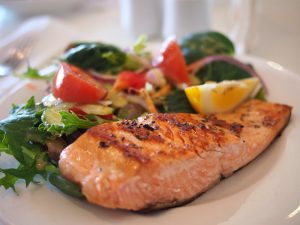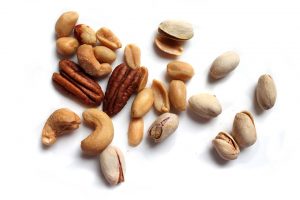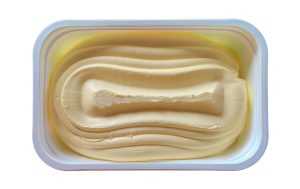Breaking Down Types of Fats
Did you know that there are several different types of fats? From butter to lard or oil, fats can be very different from one another and have different effects on the body.
Some are necessary for proper body function, some can increase blood cholesterol levels, and some can reduce the risk of heart disease. Knowing which type of fat does which can help us make healthier food choices.
The Essential Fats
Two types of fats are needed in the diet to keep our bodies healthy and functioning properly. These fats are called alpha-linolenic acid and linoleic acid. They are usually referred to as omega-3 and omega-6 fats.
Omega-3

Omega-3s are important for heart and brain health and the very best source is fish. This type of fat is often too low in the American diet, so it is important to focus on getting enough. Here are some sources of omega-3 fats:
- Fatty fish like salmon and anchovies
- Soybean oil
- Canola oil
- Walnuts
- Brussel sprouts
- Spinach
Omega-6

Omega-6s are also important for brain health as well as growth, development. The American diet is high in omega-6 fatty acids, and we usually do not need to worry about getting enough. Here are some food sources of omega-6s:
- Chicken
- Nuts
- Vegetable oils
- Cereals
The “Bad” Fats
Two types of fats are considered to be unhealthy because they increase the risk for heart disease.
Saturated Fat

Saturated fats are often also called “solid fats,” since they are solid at room temperature. Saturated fat usually comes from animal sources – like butter, chicken fat, and beef fat. Two plant fats are saturated – coconut oil and palm oil. Research strongly suggests that higher intake of saturated fat raises risk factors for heart disease. Keeping saturated fats below 10% of total calories decreases these risks. Lowering intake of saturated fats even more comes with greater health benefits. Most Americans get more than 10% of calories from saturated fat, so it is important to focus on lowering intake. Here are some tips on reducing saturated fat in the diet:
- Replace whole milk with reduced fat or skim
- Replace butter in recipes with canola or olive oil
- Buy leaner meats
- Trim fat from chicken, beef, and pork before eating it
Trans Fat

Trans fats are naturally present in some foods and are also formed during food processing. These fats are strongly believed to increase the risk for cardiovascular disease. Trans fats should be as low as possible in the diet. Look at the Nutrition Facts label on packaged foods to see how much trans fats a product contains.
The Good Fats
Unlike saturated fats, unsaturated fats are considered healthy, and they are liquid at room temperature. Unsaturated fats are found in plants and seafood. The main types of unsaturated fats are monounsaturated fat and polyunsaturated fats. Unsaturated fats are often found as oils extracted from plants. The majority of fats in the diet should come from unsaturated fats.
Monounsaturated Fat

Monounsaturated fat is a type of unsaturated fat that is thought to lower the risk for heart disease and stroke. Oils high in monounsaturated fat also tend to be high in vitamin E, which is an important antioxidant that many Americans do not get enough of. Here are some sources of monounsaturated fats:
- Olive oil
- Canola oil
- Peanut oil
- Avocados
- Peanut butter
Polyunsaturated Fats

Polyunsaturated fats are healthy when used to replace saturated fat in the diet. This type of fat is also thought to reduce the risk for heart disease and stroke. Omega-3 and omega-6 fats are necessary for the body to function and are types of polyunsaturated fats. Here are some sources of polyunsaturated fats:
- Soybean oil
- Corn oil
- Sunflower oil
- Fatty fish
- Walnuts
Posted April 15th, 2015